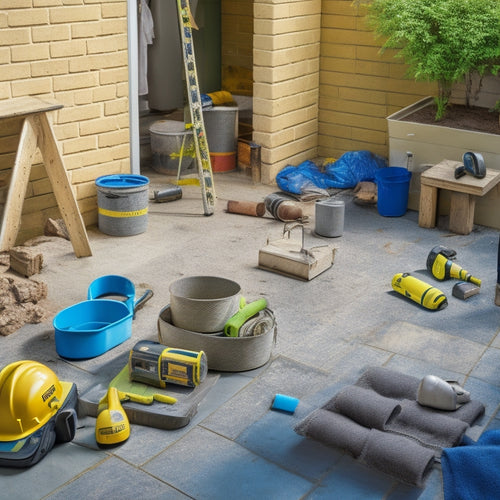
Compliance Checklist for Home Renovation Projects
Share
When tackling a home renovation project, you'll need to verify compliance with various regulations and standards to avoid costly rework, fines, and even project shutdowns. You'll need to verify that your design and construction plans align with local building codes and regulations, obtain necessary permits and approvals, and schedule inspections with local authorities. Additionally, you'll need to take into account zoning and land use regulations, disability access compliance standards, and environmental sustainability requirements. By understanding these requirements, you'll be well on your way to a successful project - and there's more to explore to guarantee your project meets all the necessary guidelines.
Key Takeaways
• Verify that design and construction plans comply with local building codes, zoning regulations, and accessibility standards.
• Obtain necessary permits and approvals from local authorities before commencing the project.
• Ensure that the renovation meets environmental sustainability requirements, such as energy efficiency and water conservation.
• Conduct regular inspections to confirm compliance with building codes and regulations throughout the project.
• Consult with experts to confirm compliance with disability access compliance standards and incorporate adaptive design elements.
Building Code Compliance Checks
As you commence your home renovation project, you must confirm that your design and construction plans comply with the local building codes and regulations, which can vary significantly depending on your location.
It's crucial to stay up-to-date with the latest building code updates to guarantee residential safety and avoid costly rework or even project shutdowns. Familiarize yourself with the International Residential Code (IRC) and the International Building Code (IBC), which serve as the foundation for local building codes.
Additionally, research local amendments and ordinances that may supersede national codes. Verify that your plans meet the requirements for structural integrity, fire safety, accessibility, and energy efficiency.
Don't assume that your contractor or designer is aware of the latest codes; take an active role in confirming compliance. By doing so, you'll not only avoid potential risks and liabilities but also create a safe and comfortable living space that meets the highest standards of quality and performance.
Zoning and Land Use Regulations
You must verify that your home renovation project complies with local zoning and land use regulations, which dictate how property can be used, divided, or developed within a specific area. These regulations vary depending on the location, so it's vital to research and understand the specific rules that apply to your property.
Zoning restrictions may limit the size, type, or placement of structures on your property, while land use regulations govern the activities that can be conducted on your land.
You'll need to review your local government's zoning ordinance and land use plans to make sure your project aligns with these requirements. Check if your renovation plans comply with the zoning restrictions on building height, setbacks, and lot coverage.
Additionally, verify that your project doesn't conflict with any land use designations, such as historic districts or environmentally sensitive areas. Failure to comply with these regulations can result in project delays, fines, or even project abandonment.
Permits and Inspections Required
Your home renovation project will require various permits and approvals from local authorities, which serve as proof that your project complies with building codes, zoning regulations, and safety standards.
You'll need to submit permit applications for electrical, plumbing, and structural work, among others. It's crucial to research the specific permits required for your project, as these vary depending on your location and the scope of work.
Once you've submitted your permit applications, you'll need to schedule inspections with local building authorities. These inspections guarantee that your project meets the required standards and codes.
You should plan for multiple inspections throughout the project, including a final inspection before obtaining a certificate of occupancy. Create an inspection schedule to stay on track and avoid delays.
Remember to budget time and resources for the permit application and inspection process. This may include fees for permits, inspections, and re-inspections.
Disability Access Compliance Standards
The Americans with Disabilities Act (ADA) and local disability access compliance standards dictate that your renovation must incorporate specific design elements and features to guarantee equal accessibility for all users, regardless of their abilities.
As you plan your renovation, you'll need to make certain that your design is inclusive and adaptive, incorporating accessibility features that cater to diverse needs. This might include installing ramps, widening doorways, and creating accessible bathroom and kitchen facilities.
You'll also need to take into account adaptive design elements, such as lowered countertops and sinks, grab bars, and non-slip flooring. Additionally, you may need to install specialized equipment, like elevators or stairlifts, to facilitate access to multi-level homes.
It's essential to consult with experts and conduct thorough research to confirm that your renovation meets the necessary standards. By prioritizing accessibility, you'll create a space that's welcoming and usable for everyone, regardless of their abilities.
Environmental Sustainability Requirements
How will your renovation project minimize its ecological footprint and comply with environmental sustainability requirements, which are increasingly becoming a crucial aspect of home renovation compliance? As you plan your project, it is important to reflect on the environmental impact of your materials, energy consumption, and waste management.
To guarantee compliance, you should focus on incorporating sustainable materials, optimizing energy efficiency, and reducing waste. Here are some key considerations:
| Sustainability Aspect | Compliance Requirements |
| Materials | Use sustainable materials with low embodied energy, such as recycled materials, sustainable wood, and low-VOC paints |
| Energy Efficiency | Install energy-efficient appliances, lighting, and HVAC systems to reduce energy consumption |
| Water Conservation | Install low-flow fixtures and greywater reuse systems to minimize water waste |
| Waste Management | Implement a waste management plan to minimize waste, recycle materials, and dispose of hazardous waste properly |
Frequently Asked Questions
What Is the Average Cost of a Home Renovation Project Permit?
When you're planning a home renovation, you're likely wondering what the average cost of a permit will be.
Well, it depends on the type of permit you need and your local regulations.
Building permits, electrical permits, and plumbing permits all have different fees.
On average, you can expect to pay between $500 to $2,000, but it could be more depending on the complexity of your project and your location.
You'll need to check with your local government to determine the exact costs and requirements.
Can I Do the Renovation Work Myself to Save Money?
You're considering taking the DIY route to save money, but it's essential to weigh the DIY considerations carefully.
While tackling some tasks yourself can be cost-effective, others may require specialized skills and licenses.
Be honest about your abilities and the time you can dedicate. If you're not experienced, you might end up spending more in the long run or compromising the project's quality.
Weigh the budget implications of DIY work against the benefits of hiring a professional to guarantee your renovation project meets the necessary standards.
How Long Does It Take to Get a Renovation Project Approved?
As you commence your renovation journey, you're likely wondering how long it'll take to get the green light.
The approval process can be a wild card, but expect it to take anywhere from a few weeks to several months, depending on the scope of your project.
Factor in time for plan reviews, permit issuance, and inspections – it's all part of the renovation timeline.
You'll be waiting patiently, but trust us, it's worth it to guarantee your dream renovation becomes a reality.
Are There Any Tax Benefits for Energy-Efficient Renovations?
As you commence energy-efficient renovations, you'll be pleased to know you can reap tax benefits.
You're eligible for tax credits, which directly reduce your tax liability, and energy incentives, such as rebates and deductions.
For instance, the Federal Solar Investment Tax Credit offers a credit of up to 30% of qualified expenses.
Additionally, state and local governments provide incentives, like property tax exemptions or sales tax waivers.
Research and claim these benefits to maximize your ROI.
Do I Need to Hire a Project Manager for My Renovation?
As you stand amidst the chaos of your renovation, imagine a conductor expertly guiding your project's orchestra. That's what a project manager does - harmonizing timelines, budgets, and contractors.
By hiring one, you'll reap benefits like streamlined communication, reduced stress, and a smoother renovation timeline.
Consider your project's complexity, scope, and your own availability; if you're not a seasoned renovator, a project manager's expertise will be the maestro that brings your dream home to life.
Conclusion
As you commence your home renovation project, remember that compliance isn't just a necessary evil, but a time-traveling DeLorean that will transport you to a world of safety, efficiency, and peace of mind.
By following this compliance checklist, you'll guarantee that your project is up to code, meets zoning and land use regulations, and exceeds environmental sustainability standards.
So, buckle up and get ready to ride the compliance highway to a successful renovation!
Related Posts
-

7 Crucial Tools for a Successful Stucco Renovation
To guarantee a successful stucco renovation, you'll need a range of essential tools. First, invest in a stucco mixer ...
-

7 Patio Safety Tips for DIY Renovation Projects
As you begin your DIY patio renovation project, prioritize safety by evaluating the worksite for tripping hazards and...
-

3 Best Planter Shopping Timeline Tips for Renovators
When incorporating planters into your renovation project, you'll want to plan carefully to avoid delays and guarantee...


